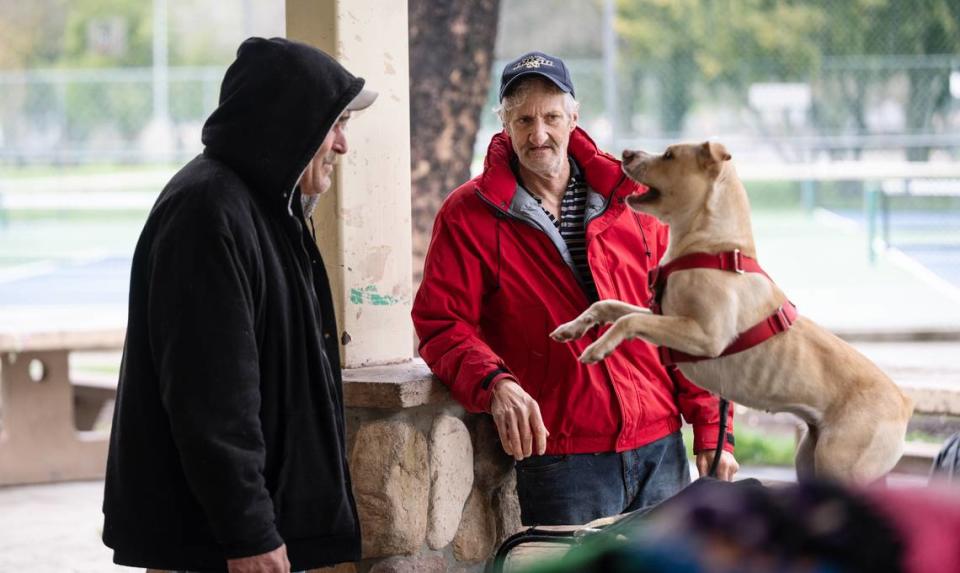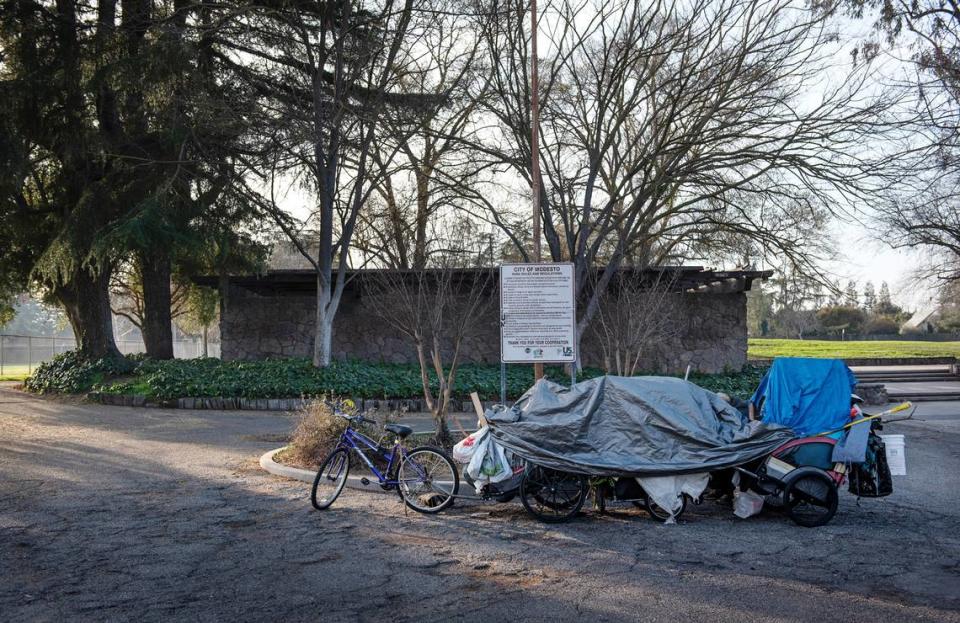Harnessing new energy to ease homelessness with tiny homes and safe camping | Opinion
I don’t blame anyone for losing hope on the homeless problem in Modesto. It seems so long since we’ve had any good news, while the situation, to anyone with eyes, is not getting better.
So my ears perked when I heard about DignityMoves. The more I looked into it, the more intriguing it became.
DignityMoves is a nonprofit focused on what they call interim supportive housing. It’s a step up from traditional emergency shelters but a half-step short of transitional housing meant for people on a path to turning their lives around.
DignityMoves’ model, in all honesty, looks like tiny homes because they’re individual living spaces instead of the barracks style usually seen in emergency shelters. Giving people their own space with a door that locks gives them a lot more privacy, and a place for pets and possessions.
Some unhoused say they’re turned off by congregate settings, sometimes with bunk beds reminding them of jail. Others don’t want to give up the few items they own. Interim housing serves the same just-off-the-streets population in a way that’s more palatable, the theory goes.

Except it’s more than just a theory.
DignityMoves has a small pilot project in San Francisco, two in Santa Barbara County and in a couple of weeks will open another in Alameda, the closest so far to Modesto. As each proves its worth, neighboring cities and counties take notice.
Modesto Councilman Nick Bavaro did. Having toured a Santa Barbara site, he arranged a conference call with some of his colleagues. Soon the city’s community development team was meeting with Marc Sabin, DignityMoves’ vice president of partnerships and programs.
In a Thursday phone call, Sabin explained the nonprofit’s secret sauce: free land, making this partial solution quick and relatively cheap. The idea is to put tiny units on unused space — maybe little-used church parking, or a vacant lot whose kindhearted owner is working through development plans — on a temporary basis, say two or three years. When the time is up, the units are forklifted to a new spot. This should be more acceptable to neighbors because they know it’s not forever.
Each interim housing pod comes with bathroom and shower facilities, dining buildings and computer labs. Offices with case managers direct people to life-bettering services such as job training and finding, or addiction treatment.
The real magic, Sabin says, is the instant dignity that interim housing offers to the unhoused. When they’re not stressed about losing their pets, possessions and partners, “they’re able to hear what a case manager has to say, to lead them toward stable housing.”
Is Modesto serious about this?
“The city is looking into it as we speak,” Bavaro assured me.
He made headlines earlier this month when The Bee’s Kevin Valine outlined Bavaro’s vision for several homeless camping spots around Modesto — again, offering something different from the traditional dorm-style shelter.
Modesto Councilman Chris Ricci’s December newsletter blast caught my eye with these words: “Like you, I am frustrated beyond words at the homeless crisis in our parks and businesses,” he wrote, pushing safe camping as a possible solution.
New energy in Modesto
“I’m enthusiastic about Nick’s ideas,” Ricci told me on the phone. “There is significantly more energy now behind trying innovations on homelessness than there was on the previous council.
“The frustrating part is there is not just one thing anyone can do to fix it,” he continued. “We’re going to have to do multiple programs.”
He’s right.
For a problem as intractable as homelessness, there is no silver bullet. There is a need for the Modesto Gospel Mission and the Berberian Shelter and safe camping and interim housing and transitional housing, and day centers giving people an alternative to loitering in parks.
Every unit of affordable housing we can add to Modesto’s inventory eases the incredible pressure on our housing stock. So mother-in-law-quarters, or accessory dwelling units, and the 79-home transit-oriented development proposed on Seventh Street represent needed, affordable relief.

To Modesto’s south, good for the adults in the room on the Ceres City Council who were able to see past the whining of NIMBYs (not in my backyard!) to recently approve 145 apartments a short walk from Mitchell Road stores. Mayor Javier Lopez and council members Bret Silveira and Rosalinda Vierra had the good sense to do what a previous council four years ago didn’t have the guts to.
Farther south, good for the adults in the room on the Turlock City Council who saw past the whining of NIMBYs to approve transitional housing in shipping containers — why not? — on Tuesday. Kudos to Mayor Amy Bublak and Councilwomen Rebecca Monez and Cassandra Abram, whose wisdom overcame two hours of fear in the form of public comment.
“It’s out there in nowhere land,” Bublak said of the location, a city-owned lot in an industrial zone on South Walnut Road — not close to homes or schools, but within walking distance of shops and transit. “It’s an absolutely secure place. I feel it’s the perfect spot for a pilot program, to find out whether people want to become a productive member of society or they’re just comfortable being lawless.”
It’s past time to try all of these measures, and more.
California’s No. 1 problem
Without question, homelessness was the No. 1 topic of discussion over the past few days at the California State Association of Counties’ legislative conference, where Stanislaus Supervisor Vito Chiesa and Modesto Mayor Sue Zwahlen presented our approach.
“For the last three days, that’s all I’ve heard” is homelessness, Stanislaus Supervisor Mani Grewal said in a phone conversation. “It is the statewide issue at the top of everyone’s mind.
“There is not just one idea to get behind. We’re going to need a bunch of good ideas, and I say we need to try everything.”
As Ricci told me, “We need to stop pretending that homeless people are a monolith, and create a menu of solutions.”
Those ranting that we need to teach the homeless a lesson by throwing them in jail are not facing reality. The problem does not disappear just because someone has moved them out of sight.
If the solution were easy, it would have been found and implemented long ago. Neither is it simply a matter of throwing money at the problem. Where have billions of dollars spent in the past few years gotten us, if California still has 170,000 homeless?
It does feel, however, like Stanislaus County and some of its cities have mustered more political will to confront homelessness, as illustrated by Modesto exploring the DignityMoves model.
May they keep at it without faltering. All our people — with and without homes — deserve better than we’ve had.

